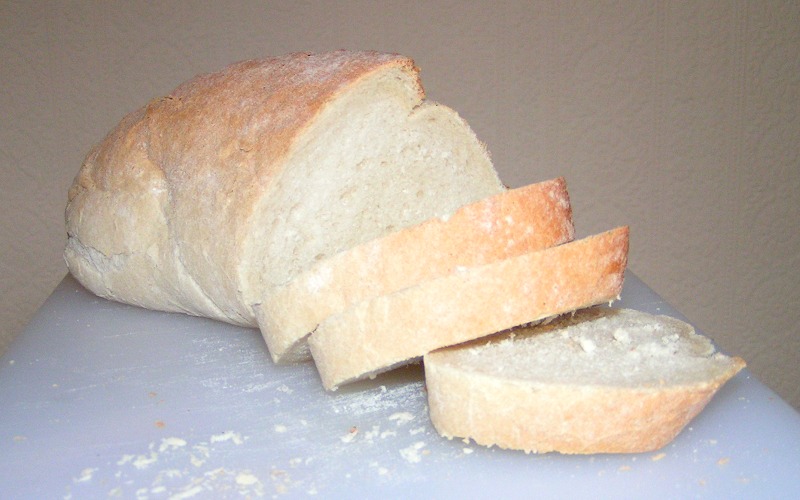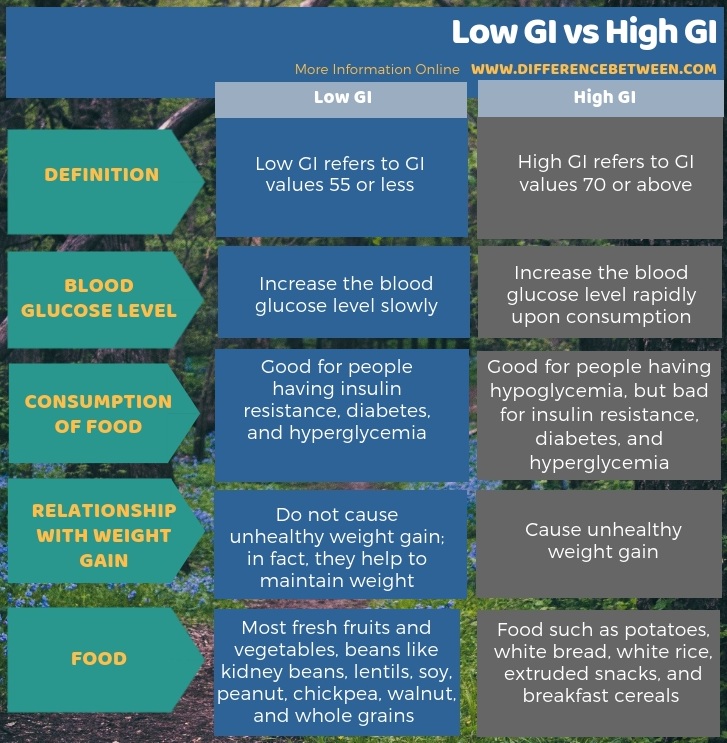Difference Between Low GI and High GI
Table of Contents
The key difference between low GI and high GI is that low GI refers to levels of 55 or less, which are good for our health, while high GI refers to the levels of 70 or above, which are bad for our health.
Glycemic Index (GI) is an index which shows the rate of blood sugar level rising after consuming a particular meal. The standard used to measure all other food GIs is pure glucose, which gives the value of 100 by default. For ease of application, there are three identified main ranges of GI such as Low GI (55 and less), Medium GI (56-69), and High GI (70 and above). Although a food gives a particular GI value, it may deviate in a range due to various reasons such as batch or crop, methods of processing, packing and storing etc.
CONTENTS
1. Overview and Key Difference
2. What is Low GI
3. What is High GI
4. Similarities Between Low GI and High GI
5. Side by Side Comparison – Low GI vs High GI in Tabular Form
6. Summary
What is Low GI?
Low GI food have Glycemic Index 55 or less. Low GI food increases the blood glucose level slowly, unlike other food. This happens because low GI food release glucose slowly and steadily with time. It allows the body to use energy efficiently. There is no requirement of storing energy when there is no excess of energy. Therefore, this type of food won’t result in an unhealthy weight gain.

Figure 01: Low and High GI
Low GI food is highly recommendable for people suffering from insulin resistance, diabetes, or hyperglycemia. This is because they essentially need to maintain low blood glucose levels and low variation. Most fresh fruits and vegetables are low GI foods. Furthermore, beans such as kidney beans, lentils, soy, peanut, chickpea, walnut, and whole grains are very good examples of low GI foods. However, low GI does not necessarily mean that the carbohydrate content of food is low. Hence, it is better to know the value of the glycemic load of a certain food item prior to consuming.
What is High GI?
High GI foods have a Glycemic index of 70 and higher. When we consume high GI foods, our blood glucose level rises very rapidly. This is an intense fluctuation of blood glucose level called “sugar spike”. Due to this rapid introduction of glucose, the body cannot use the load very efficiently and tends to store it as glycogen or fat. This results in unhealthy weight gain.

Figure 02: High GI Food – White Bread
Moreover, high GI food consumption is dangerous for people who are suffering from diabetes, hyperglycemia and insulin resistance. However, it is advisable that people suffering from hypoglycemia (low blood sugar) should take more of high GI food in their diets in order to maintain healthy blood glucose levels. Despite having negative effects, high GI foods are suitable for situations such as after exercising, running a race, etc. where energy supply should be quick. Food such as potatoes, white bread, white rice, extruded snacks, and breakfast cereals are popular high GI foods. It is important to know that intake of high GI food can damage the liver and cardiovascular system in the long run. In some incidents, it also can affect your eyes and brains.
What are the Similarities Between Low GI and High GI?
- Both low and high GI values are a relative ranking of carbohydrate in the food according to how they affect blood glucose levels.
What is the Difference Between Low GI and High GI?
Low GI refers to the level of 55 or less while high GI refers to the level of 70 or above. Thus, this is the key difference between low GI and high GI. Low GI foods increase the blood glucose level slowly. In contrast, high GI foods increase blood glucose level rapidly. Hence, this is another difference between low GI and high GI. Low GI foods do not cause weight gain, but high GI foods cause weight gain. Thus, this is also a difference between low GI and high GI.

Summary – Low GI vs High GI
Glycemic index is a measurement of carbohydrate food in relation to their ability to increase blood glucose level. Based on that, there are three levels as low, medium and high. Low GI indicates GI value 55 or less while high GI indicates GI value 70 or above. This is the key difference between low GI and high GI. Low GI foods are good for our health since they increase blood glucose levels slowly and steadily. Moreover, they do not cause weight gain. On the other hand, high GI foods are bad for our health. They increase our blood glucose level rapidly. Hence, they cause weight gain. This summarizes the difference between low GI and high GI.
Reference:
1. “About Glycemic Index.” Glycemic Index Foundation, Available here.
Image Courtesy:
1. “Glycemic” By Studio34 at English Wikipedia – Transferred from en.wikipedia to Commons (Public Domain) via Commons Wikimedia
2. “White bread 800” By User Sannse on en.wikipedia (CC BY-SA 3.0) via Commons Wikimedia
ncG1vNJzZmivp6x7pbXFn5yrnZ6YsqOx07CcnqZemLyue8OinZ%2Bdopq7pLGMm5ytr5Wau264zrBkoKFdlruledWsZKGhl516qLWO